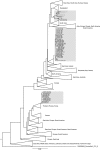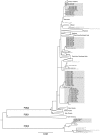The emergence of rotavirus G12 and the prevalence of enteric viruses in hospitalized pediatric diarrheal patients in southern Vietnam
- PMID: 21976585
- PMCID: PMC3183790
- DOI: 10.4269/ajtmh.2011.11-0364
The emergence of rotavirus G12 and the prevalence of enteric viruses in hospitalized pediatric diarrheal patients in southern Vietnam
Abstract
Diarrhea is a major cause of childhood morbidity and mortality in developing countries, and the majority of infections are of viral etiology. We aimed to compare the etiological prevalence of the major enteric viruses in an urban and a rural setting in southern Vietnam. We simultaneously screened fecal specimens from 362 children in Ho Chi Minh City and Dong Thap province that were hospitalized with acute diarrhea over a 1-month-long period for four viral gastrointestinal pathogens. Rotavirus was the most common pathogen identified, but there was a differential prevalence of rotavirus and norovirus between the urban and rural locations. Furthermore, rotavirus genotyping and phylogenetic analysis again differentiated the genotypes by the sampling location. Our data show a disproportional distribution of enteric viral pathogens in urban and rural locations, and we provide evidence of continual importation of new rotavirus strains into southern Vietnam and report the emergence of rotavirus genotype G12.
Figures




References
-
- Bryce J, Boschi-Pinto C, Shibuya K, Black RE. WHO estimates of the causes of death in children. Lancet. 2005;365:1147–1152. - PubMed
-
- Hogberg U. The World Health Report 2005: “make every mother and child count”—including Africans. Scand J Public Health. 2005;33:409–411. - PubMed
-
- Davidson G, Barnes G, Bass D, Cohen M, Fasano A, Fontaine O, Guandalini S. Infectious diarrhea in children: Working Group Report of the First World Congress of Pediatric Gastroenterology, Hepatology, and Nutrition. J Pediatr Gastroenterol Nutr. 2002;35((Suppl 2)):S143–S150. - PubMed
Publication types
MeSH terms
Grants and funding
LinkOut - more resources
Full Text Sources
Medical

